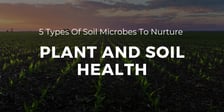By Kaitlyn Ersek on Jan 10, 2019 4:40:00 PM
.png?width=650&name=Blog%20posts%20(12).png)
When was the last time you took soil tests at your property? Are your plants looking a little worn out? Are your turf and plants not taking to fertilizer applications?
Soil tests provide the key soil health metrics you need to better prescribe a fertility program for your property.
On a basic level, soil tests indicate nutrient deficiencies and pH levels. However, more advanced soil tests are available that also indicate Cation Exchange Capacity (CEC), soluble salts and other important soil health metrics.
What is each of the soil health metrics you can expect from a soil test, what do they mean and what practices can you put in place to improve results?
Measuring key elements to plant growth
According to the University of Minnesota Extension, “There are at least 17 essential elements required for plant growth: carbon, hydrogen, oxygen, nitrogen, phosphorus, potassium, calcium, magnesium, sulfur, iron, manganese, zinc, copper, boron, molybdenum, chlorine and nickel.”
While elements like hydrogen, carbon, and oxygen are taken from air and water, the remaining elements are derived from the soil. When the soil is lacking in a key element, adding fertilizer is key.
The three most important nutrients for plant growth include: nitrogen, phosphorus, and potassium.
1. Nitrogen is responsible for stimulating strong plant growth and promoting the green coloring of foliage (it helps with chlorophyll production). Nitrogen is often present in the soil; however, it may be locked in a form that isn’t utilized by the plant. Adding a fertilizer containing nitrogen will directly supply the nutrient to the plant. You could also add a probiotic containing nitrogen-fixing bacteria that will unlock nitrogen already present in the soil, making them available to the plant.
2. Phosphorus is responsible for assisting with the growth of roots and flowers. It also helps plants withstand environmental stress and harsh winters. Just like with nitrogen, phosphorus is often contained in the soil but may be locked in a form the plant can’t use. Adding a fertilizer containing phosphorus or adding a probiotic containing phosphorus-solubilizing bacteria can increase the supply of available phosphorus.
3. Potassium strengthens plants, contributes to early growth, and helps retain water. It also affects the plant’s disease and insect suppression. Adding a fertilizer containing potassium will offset any imbalances in the soil.
>>For information on the six essential nutrients for plant health, read our blog here.
Looking at soil pH
Soil pH is a measure of soil acidity. A pH of 7 is neutral; anything below 7 is acidic and anything above is alkaline.
According to the University of Minnesota Extension, “A soil pH is an important chemical property because it affects the availability of nutrients to plants and the activity of microorganisms in the soil.”
On average, most plants prefer a soil pH between 6.0 and 7.0 and most turf grasses prefer a pH of 5.5 and 6.5. However, pH can differ depending on the plant and turf grass you are growing.
Adding lime is one common practice to raise the soil's pH. Tools that lower pH includes but are not limited to: sulfur, iron sulfate, aluminum sulfate, acid sphagnum peat, and ammonium sulfate/urea.
Cation Exchange Capacity
Think of the soil as the pantry for plants, storing the necessary nutrients to feed the plant and ultimately boosting plant health. The Cation Exchange Capacity (CEC) is the soil’s ability to maintain and release nutrients to the plant.
So, the higher the CEC, the larger the pantry and the more “food” the soil has the ability to store and feed to the plant.
To increase CEC levels, adding a product with high microbial populations will stimulate the digestion of organic matter, increasing humus levels, which thereby increases CEC levels.
>>Dig deeper into Cation Exchange Capacity and how Holganix boosts CEC levels
Soluble salts
Soluble salts are the ions that are dissolved in soil water.
Why are soluble salts important? “High soluble salts can reduce water uptake by plants, restrict root growth, cause burning of the foliage, inhibit flowering, and limit fruit and vegetable yields.”
Some soils naturally have high soluble salts, however human practices like over-fertilizing, pet urine, or using snow salts on sidewalks/streets can all increase soluble salt levels.
To correct soluble salt problems, look at incorporating gypsum and leaching the soil with good-quality water.
How and where do you conduct soil tests?
Results from soil tests often take a couple of weeks and possibly a couple of months depending on the test. Most university extensions offer soil testing.
Utilize a sampling tube and take several samples at each location of your property. Look at taking 3-inch to 6-inch deep soil samples. Remember to label each tube with the location of the property from which it was taken.
Using Microbials To Improve Soil Health
Holganix Bio 800+ Agriculture charges soil with over 800 species of soil microbes to improve plant performance. What does that mean for you?
That means you build soil and root health, adding the benefits of better soil structure to whatever soil type you have. This translates to improved yield on crops, better playability on golf courses, and a reduced need for fertilizers and pesticides on lawns.
Learn more about the science behind Holganix Bio 800+ Agriculture below.















